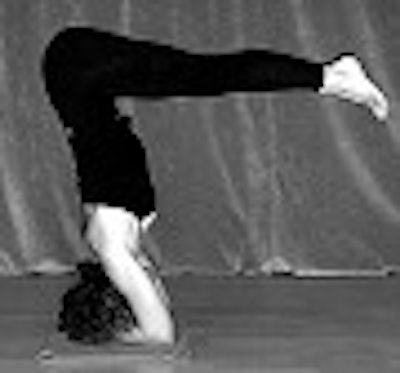
How do you know when something has become an official part of mainstream culture? Two words: franchise and fashion.
That mainstream moment of glory arrived this year for the 5,000-year-old practice of yoga, a form of mind-body exercise that combines stretching and controlled breathing with spiritual teachings.
First, self-styled guru Bikram Choudhry set up what is considered the only yoga franchise in the U.S. The Los Angeles-based founder of Bikram -- an intense form of yoga done in a room heated to at least 100° F -- has trademarked his particular brand of practice. He now rigorously purses legal action against those who teach it without his blessing -- that is, without paying his licensing fees (Los Angeles Times, July 7, 2002).

The second sign arrived in October, when supermodel Christy Turlington appeared on the cover of Vogue magazine, executing standard hatha yoga poses -- called asanas in Sanskrit -- while decked out in designer duds (right; image courtesy of Conde Nast Online).
What’s the fuss all about? Why are people all over the world willing to drop into downward-facing dog, camel pose, or one of the hundreds of other asanas that make up the yoga curriculum?
A 1998 Wall Street Journal survey estimated that 18 million people in the U.S. alone practice some form of yoga. Since yoga was introduced to the western world in 1920 by Indian spiritualist Paramahansa Yogananda, it’s become big business. New yoga studios seem to open on a daily basis; there are countless yoga-based books and videos on the market; yoga accessories are coveted by those who have never made it through a sun salutation; even Madonna has jumped on the yoga bandwagon (below).
 |
| In the 2000 film "The Next Best Thing," the script called for Madonna to portray a swimming instructor. Madonna changed her character’s career to that of a yoga teacher. Image courtesy of Paramount Pictures. |
But while the masses may have just gained consciousness about yoga, the medical community has been hip to the virtues of yoga for some time. From cancer treatment at Memorial Sloan-Kettering to alleviating anxiety in psychiatric patients, this ancient exercise is being integrated into modern healthcare. To that end, imaging specialists are doing their part to study and quantify the affects and possible advantages of yoga.
Stretch and (dopamine) tone
One of goals of a yoga practice is to achieve relaxation, mood stabilization, and a sense of focus, but how does it actually do that? European researchers set out to answer this question with PET imaging in a study published in Cognitive Brain Research.
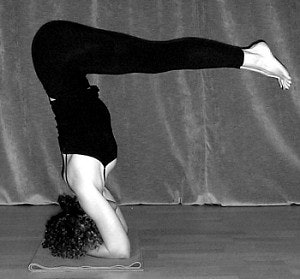 |
| Arda Sirsasana, or supported half headstand, is credited with calming the brain and relieving stress. All yoga pose images courtesy of Leslie Howard. |
"This study was inspired by studies on (attention deficit/hyperactivity disorder)," wrote lead author Dr. Troels Kjaer, Ph.D., in an email to AuntMinnie.com. "These patients seem to have a hypofunction of the cortico-striato-thalomo-cortical loops." Kjaer is with the John F. Kennedy Institute in Glostrup, Denmark; his co-investigators hailed from the MRCI Clinical Sciences Centre in London and the Danish Epilepsy Hospital in Dianlund, Denmark.
In previous studies, Kjaer and his colleagues found that meditation during yoga nidra brought on significant blood-flow changes in the cortex as measured by H2O-PET, including a relative flow decrease in the executive system of the brain: dorsolateral prefrontal, anterior cingulate, and orbital frontal cortices, striatum, thalamus, brain stem, and cerebellum (Human Brain Mapping, 1999, Vol.7:2, pp. 98-105).
Subjectively, yoga meditation is characterized by reports of vivid imagery and decreased attention towards action, Kjaer and colleagues wrote in Cognitive Brain Research.
"We hypothesized that the voluntarily induced suppression of the executive system during relaxation meditation could be mediated by the dopaminergic system," they wrote. "This hypothesis would predict reduced binding of 11C-raclopride to D2 dopaminergic receptions during relaxation meditation." Control over the cortico-striato-thalomo-cortical loops could potentially aid in the management of disorders such as ADHD (Cognitive Brain Research, April 2002, Vol.13:2, pp. 255-259).
For this study, eight healthy yoga teachers (all male, ages 31-50) underwent two 11C-raclopride PET scans on separate days: once while performing yoga meditation and once during rest. An ECAT Exact 3-D scanner (CTI Molecular Imaging, Knoxville, TN) was used; the subjects were positioned in a supine position with the head placed in a holder. The participants were guided by an audiotape through 72 minutes of either relaxation meditation, or, in the control group, a speech given by the same narrator.
11C-raclopride was injected intravenously seven minutes after the tape was started. Scans, with a reconstruction spatial resolution of 4.8 x 4.8 x 5.6 mm, were acquired as 24 time frames over 85 minutes. Parametric images of the 11C-raclopride binding potentials (BP) were generated.
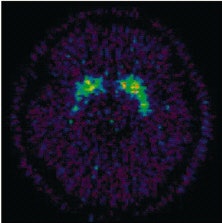 |
The 11C-raclopride binding potential images at the level of the striatum for one participant during meditation (above) and during the speech (below). 11C-raclopride binding potential in ventral striatum is evidence of increase endogenous dopamine release during meditation.
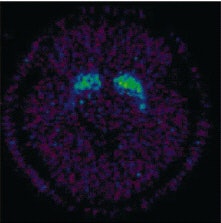 |
The group chose 11C-raclopride for this study because "raclopride is a D2 dopamine receptor ligand," Kjaer explained. "When 11C-raclopride binds to D2 receptors, it shows up as increased radioactive decay. When endogenous dopamine is produced, it tends to compete with raclopride for receptor binding, and the measured activity in a given region is reduced."
The raclopride BP scans were co-registered with T1-weighted volumetric MRI images, and five regions of interests were traced: right caudate, left caudate, right putamen, left putamen, and ventral striatum.
After the PET scans, the participants completed a questionnaire about their level of pleasure, relaxation, alertness, and awareness.
According to the results, there was a significant decrease (7.9%) in BP in the ventral striatum. During active meditation, the participants reported a significant decrease in their readiness for action (p<0.05) along with heightened sensory imagery (p<0.05).
"The major finding of the present study has been the demonstration of increased dopaminergic tone in the ventral striatum during an altered conscious state...the fact that the ventral striatum was the only region in which the decrease in dopamine receptor availability reached statistical significance is of interest. Two of the three front-subcortical circuits regulating behavior include structures in the ventral striatum," the authors explained.
A dysfunction in these circuits may indicate an orbitofrontal syndrome with a resulting lack of interest and initiative. "This increase in dopaminergic tone, therefore, seems to be associated with the observed reduction for action during meditation," the authors wrote. "To our knowledge this is the first time evidence has been provided for regulation of conscious states at a synaptic level."
Relax and say ‘Om’
In a second study, Dr. Masatoshi Itoh, Ph.D., and colleagues from Tohoku University in Aramaki, Japan studied seven yogis with whole-brain FDG-PET to determine yoga’s effects on regional brain metabolism.
"People of the modern age suffer greatly from disorders related to stress. Yoga is a choice of treatment having a unique contribution to restore the brain function related to the psychic center from where psychosomatic stress disorders are initiated," wrote Itoh in a poster presentation at the 2002 Society of Nuclear Medicine meeting in Los Angeles. Itoh’s co-authors were Dr. Laxmi Narayan Singh and Dr. Keiichiro Yamaguchi, who like Itoh are from the university’s Cyclotron Radioisotope Centre.
For this study, the participants practiced selected asanas for one hour after oral intake of 40 MBq of 18F-FDG. The subjects ranged in age from 38 to 49 years, and some had practiced yoga for more than 8 years.
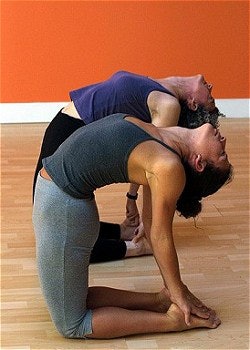 |
| Ustrasana, also known as the camel pose. |
"An advantage of oral intake is a slow input curve that enables recording of brain activity at deeper yoga states," the authors explained.
An SET 2400W PET scanner (Shimadzu Medical Systems, Kyoto, Japan) was used in 3-D acquisition mode with attenuation correction. The data was analyzed using SPM96 software (Wellcome Department of Imaging Neuroscience, University College London, U.K.). The results from the yoga PET scans were compared to controls. The threshold for significance was p<0.001.
According to the results, in the control subjects, "brain activation were found mainly in the neocortices that related with body movements and integration of sense and motion," the researchers wrote.
In the yoga group, "metabolic reduction, which was more prominent than activation, was found in mainly the deep brain structures, such as front cortices, limbic brain, mid-brain, cerebellum, and brain stem."
Their results suggest that metabolic reduction in the deep brain structures support that hatha yoga relaxes neural substrates, especially in the limbic system, cerebellum, and spinal cord, Itoh and colleagues concluded. The latter structures "are responsible for anxiety, anger, and stress-related psychosomatic disease," they wrote.
Take two asanas and call me in the morning
While imaging continues to prove -- or disprove -- the value of yoga, the practice continues to find a place in the pantheon of alternative medicine. At the National Center for Complementary and Alternative Medicine (a division of the National Institutes of Health in Bethesda, MD), two clinical trials are under way centering on yoga.
One will evaluate the effectiveness of a daily, eight-week treatment for insomnia using yoga and relaxation. The outcomes measures will include daily sleep diaries, questionnaires, ambulatory overnight polysomnography (EEG), and 24-hour urinary endocrine measures, said Sat Bir Singh Khalsa, Ph.D., the principal investigator at Brigham and Women’s Hospital in Boston.
A second trial, out of the Oregon Health Sciences University in Portland, will study whether yoga improves cognitive function and attention control in elderly people as well as in patients with multiple sclerosis.
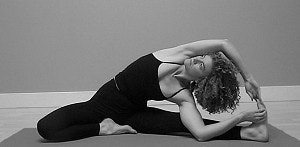 |
| Parivrtta Jana Sirsasana, or revolved head-to-knee forward bend. |
Earlier this year, at the 2002 Yoga for Positive Health conference in Sydney, Australia, researchers from the University of Sydney reported on yoga’s impact on the behavior of boys with ADHD. One group of boys attended a one-hour yoga class every week for 20-weeks; a control group partook in social cooperative games. The boys’ attention and behavior was assessed.
The parents of the boys in the yoga group reported significant improvements in secondary and co-morbid symptoms of ADHD, including favorable results on the Conner’s Parent Rating Scale for restless/impulsive behavior (p=0.016).
One challenge that neuroimagers face is studying patients while they are actually in yoga poses; most studies to date have been done with the patient in a supine position during meditation, or after a practice session. Still, researchers are taking steps towards functional imaging of yoga: At the Vivekananda Kendra Yoga Research Foundation in Bangalore, India, preliminary studies on meditation and functional MRI are underway.
And while the medical community continues to explore the benefits of yoga for its patients, one doctor recommends that physicians roll out their yoga mats and heal themselves.
"Regular practice is helping me very much especially considering my irregular schedule as a doctor and (the) stresses of emergency medicine," commented Dr. Manoj Naik, a family physician in Pune, India. "Until doctors practice, they won’t be able to (fully) understand the benefits of yoga" (Yoga Rahasya, 2001, Vol.3:3).
By Shalmali PalAuntMinnie.com staff writer
December 31, 2002
Related Reading
Ice cream pretreatment improves myocardial sestamibi imaging, October 18, 2002
Good to the last drop: Caffeine enhances BOLD fMRI results, May 14, 2002
Melatonin puts kids to sleep, makes MRI a dream, December 10, 2001
MR tracks effects of herbal treatment for prostate cancer, June 5, 2001
Blueberry juice enhances pediatric MR urography, April 26, 2001
Copyright © 2002 AuntMinnie.com



















